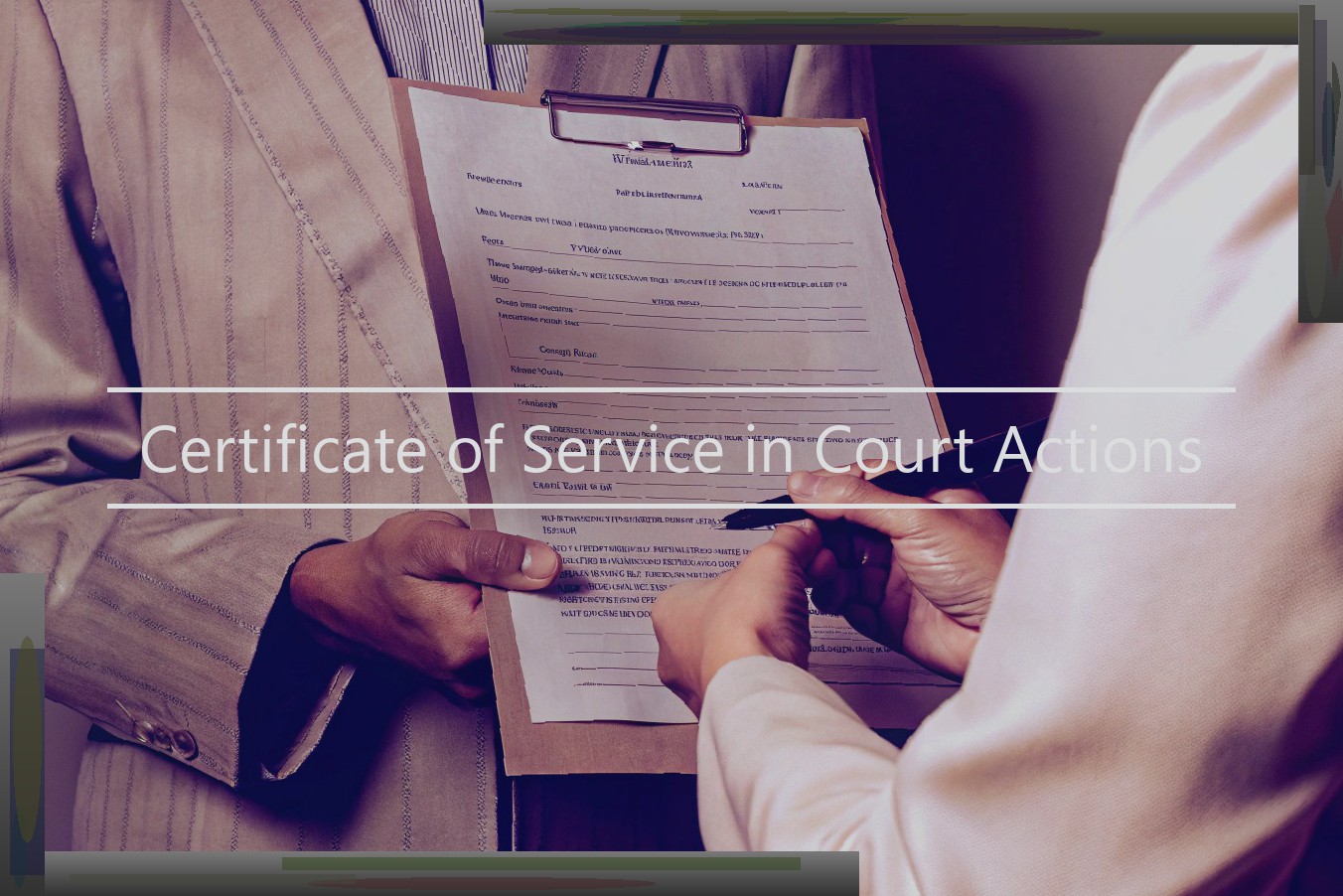Certificate of Service in Court Actions
What is a Certificate of Service and What is it For?
The Certificate of Service in court proceedings is a document prepared by a lawyer or a self-represented party after serving material to other people involved in a proceeding. It certifies to the court that the party served the material on everyone who needed to be served with it. A Certificate of Service must be signed, dated, and filed with the court.
A Certificate of Service is important in a court proceeding because it provides the judge and other parties with certainty that the person being served has in fact received a copy of the material. Where a hearing date has been set for example, the court needs to know that anyone who will be affected by the outcome of the hearing has been notified about it . Further, anyone in a position to make meaningful submissions regarding the hearing should be appropriately notified so that he or she is aware of the opportunity to defend their position.
The Certificate of Service is not a complete safeguard against service issues arising. If, for example, the opposing party at the very last minute has some material that is crucial to its case from the decision and this material suddenly does not get served on anyone in time, the judge may delay that hearing date until all parties are given a fair chance to review the material and respond to it.

The Elements of a Certificate of Service
The essential components of a certificate of service generally include the names of the parties and/or counsel involved, the documents that were served, the method of service, and the date of service. For example, a certificate of service may list the parties as the plaintiff’s name and/or counsel, and the defendant’s name and/or counsel. It may state the method in which service was made, whether it was in-person or via email, U.S. Mail, fax, or some other method. It also may state the date on which the document(s) was/were served.
For instance, in an interpleader action to determine who has rights to certain funds, a certificate of service may be presented to the Court as follows: The original and 2 copies of the INTERPLEADER and this Certificate of Service have been filed with the Court on June 15, 2014 and have been heretofore served by the undersigned on the following persons by mailing a copy thereof, certified by me, with first-class postage affixed to each envelope, addressed to each such person as shown by the records of the Clerk of the Court, on the 18th day of September, 2014 as follows: (1) Mary Jones 104 Main Street Ocean City, New Jersey 09001 (2) Joe Smith 123 4th Street, Apt. 1 Ocean City, New Jersey 09002 (signed) John Brown Attorney for Plaintiff As shown above, this certificate of service: Again, the exact language used in a certificate of service can vary from court to court and from one type of action to another.
How To Create a Certificate of Service
The certificate of service is generally filed in a particular form. In some courts, it may be required that the certificate of service comply with particular provisions of the rules regarding the form of court records. This can include identifying the title of each of the documents served by their respective caption. In that case, the certificate of service will look like the following form:
CERTIFICATE OF SERVICE
I hereby certify that on the [Day, Month, Year] a true and accurate copy of [Identification of Document Outlined By Caption] was served by [name of server or method of service] as follows:
[Names and Addresses of Those Served]
[Waiver of Notice nature, the date of the waiver, and the names of those who have waived notice]
The method to use to provide a certificate of service depends upon the document. For example, if you are filing the certificate of service for service of discovery responses or a motion at an attorney’s request, the certificate of service may only be signed by the attorney and not by your staff. (There are exceptions, however, and you should refer to the local rules or specific orders of the court for your jurisdiction.)
If you are filing a certificate of service for service of discovery responses or a motion and serving an expert report, the certificate of service typically must be signed by the attorney who was served. (Again, there are exceptions and you need to review local rules and specific orders of the court for your jurisdiction.)
If you are filing a certificate of service for service of a motion for extension of time, the certificate of service typically must be signed by the attorney and the party on behalf of whom the motion is filed. (Again, there are exceptions and you need to review local rules and specific orders of the court for your jurisdiction.)
Common Mistakes and Their Solutions
The certificate of service is a written indication that the other party to a court proceeding has been served with a copy of any legal documents sent to the court. It is often read by the judge before she reads your motion. The language differs slightly from court to court, but the common mistakes are similar.
Omission of Necessary Information
Attorneys and paralegals are accustomed to preparing this document as a standard operating procedure, so sometimes it can be difficult to remember that you actually need to sign it, with a date, and in some jurisdictions, with your office’s mailing address, facility’s fax number, your e-mail address or any combination thereof. In addition, a court could potentially do something unusual with this document during the course of litigation, such as having it posted onto an electronic filing/serving website or ordering it to be returned into the file. If your copy is missing any of these details, you could be forced to prepare a new document .
Improper Method of Service
The most common mistakes made when serving a certificate of service to opposing counsel are simply not serving them the correctly-numbered document. For example: A different version of the document prepared for the court was served, instead of the one with the court’s stamp. In the document you submitted to the Court, you left it blank (because the Court stamps it), then sent it to the other party to complete and send back to you. Another version of the document prepared for the court was served, instead of the one with the Court’s stamp. An easy way to prevent this mistake is to print two copies of the signed certificate of service: One to be submitted to the clerk with the motion, and another for you or your representative to use for service on the parties.
As always, it is a good idea to ask your judge’s judicial assistant if he or she has any specific preferences for document submission. These and other reasons why certificates of service could be stricken from the record can be easily avoided if the entire process is done mindfully.
Consequences for Failing to Serve
When it comes to appropriate service of the documents and obtaining a Certificate of Service, failure and delay is not only a problem for the party doing the failing and delaying, but for the whole of the litigation process.
If the defendant is not served within 120 days from the date of the original complaint against them, then the Court must dismiss the action or drop the defendant. Alternatively, the Court can extend that time for good cause. In short, the rule of thumb is that if a problem with service has not been rectified within 120 days, then it is probably too late to rectify it and the action will be dismissed.
For plaintiffs, this means that they have to move fast when there is a problem with service. For example, if they serve process on the wrong defendant, a plaintiff can’t just hand-deliver process to the correct defendant and expect the Court to treat it as proper service after 120 days have passed. Instead, they should make a motion to amend the complaint and then a second motion to serve the new complaint on the correct defendant.
On the other hand, while the failure to serve a defendant within 120 days may lead to a dismissal, failure to serve a plaintiff’s complaint on the defendants by the defendants’ deadline can also lead to a dismissal. New Jersey’s Court Rules provide no grace period for a defendant’s service of an answer, counterclaim, etc. on a timely filed complaint.
Benjamin H. Richman, who has relied on the relevant Court Rules for years, explained it best: "If the rules say serve it by day X you serve it by day X. If you can’t do that, then you have to take steps to rectify that by day X."
In other words, the legal consequences for not properly seizing upon service deadlines under the New Jersey Court Rules can range from sanctions imposed by the Court (like fees) to extension of the deadline to execute process. But when it comes to dismissals – where things become blunt – there is no place for excuses or "good reasons" in New Jersey State Court. There are no excuses when it comes to improperly or untimely serving process on a complaint. While judges and Courts may issue extensions, for sheer failure to follow the Court Rules, the Court’s remedy will probably be dismissal.
Certificate of Service in Various Jurisdictions
The legal requirements and practice regarding a Certificate of Service may differ from jurisdiction to jurisdiction. This is often the case in common law jurisdictions, in particular the United States) due to the fact that the United States is a common law system that has evolved in the context of constitutional democracy and that the Constitution prohibits Congress from passing laws that regard an individual’s access to the courts. Thus, the Supreme Court in McCarthy v. Madison, stated:
But, even if we accept as arguendo the fact that service on the attorney was not the equivalent of service on the client, we think that under all the circumstances of this case other methods of service employed were sufficient compliance with the requirements of the Connecticut statutes, and afford strong support for the finding of the trial court, affirmed by the Appellate Division, that service was made on the defendants in accordance with the statute .
The requirements for service certificates also differ within specific divisions of the United States, such as California for example, however it is not necessary to comply with these rules to effect service in an Autonomous Region such as Guam for example, although you must comply with the rules set out by the court for service of papers on the other party. A "Certificate of Service" is not a requirement in the United Kingdom, although practitioners have been known to submit them in the past. The usual practice is in the body of a Statement of Claim, the Claimant states the date of service on the Defendant, and the Solicitor who effects such service provides a letter to the Defendant with copies of the documents. More formal practices are not typically seen in everyday practice. There is no statutory requirement to submit such certificate and nor is it required when submitting case or witness bundles to the court.





